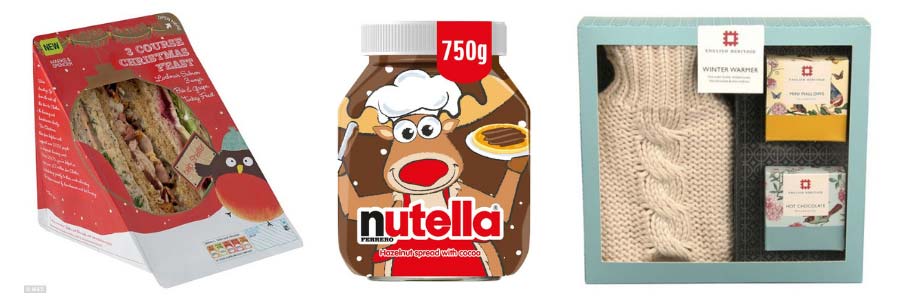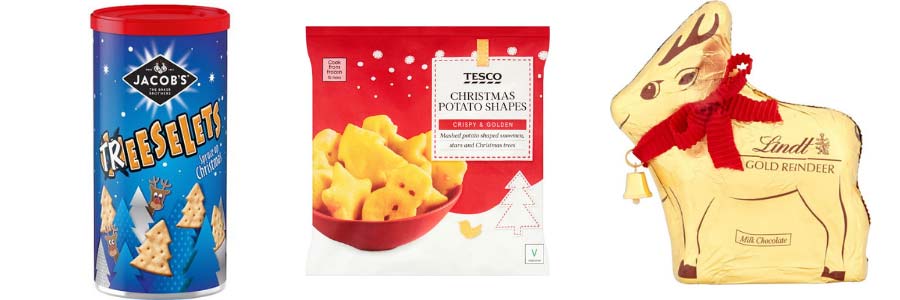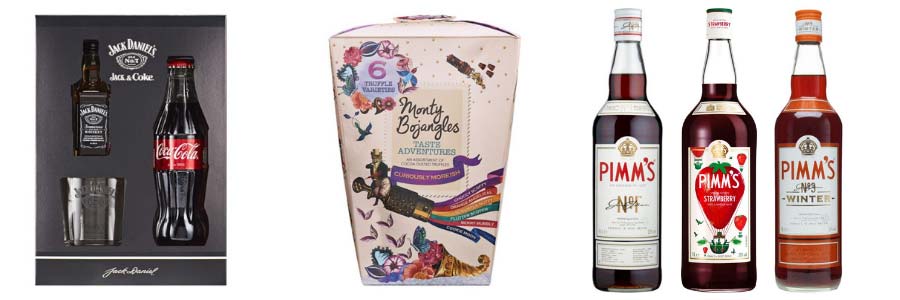![]() By Caroline Hagen
By Caroline Hagen
With Christmas festivities currently closing in on us from all angles, it’s a time when seasonal design is really brought to the fore. You find an abundance of gift packaging (especially for chocolate, beauty products and alcohol), products you would not buy for 11 months of the year – like stollen, mince pies and Christmas puddings and everyday products sprinkled with some Christmas cheer.
But actually, although it may seem like making your product ‘giftable’ is a quick Christmas win, seasonal packaging can deliver a lot more for your brand long-term, than a 6-week spike in sales.
Speciality ingredients, food & product pairing, build occasion
Christmas is the perfect opportunity to highlight your speciality ingredients and push food pairing – the Christmas sandwich; transforming the everyday bacon & sausage into ‘pigs in blankets’ makes it a desirable Christmas option. By making your everyday product ‘special’ enough for Christmas can elevate perceptions and encourage consumers back to it at other times in the year.
Products which wouldn’t normally be associated with one another or be merchandised together are brought into one pack to build occasion and transport consumers to a better place eg. a hot water bottle and chocolates for a cosy snuggle up on the sofa. It’s easy to build this occasion at Christmas when consumers dedicate more time to shopping and emotions are high. Once it’s in their head they will go back to that same occasion at other times in the year.
Different product formats, extend occasion
Christmas isn’t the only time of year marked with special seasonal design. There’s also Valentine’s Day, Mother’s Day, Easter, Father’s Day and Hallowe’en, each with its own associated colourways and expectations. Often, as in the case of chocolate, it’s an excuse to experiment with different product formats to keep the brand up-to-date and relevant, and to extend occasion – eg. where a Lindt Easter bunny becomes a Christmas reindeer, or the yolk of a Cadbury’s Creme Egg turns green and becomes a Screme Egg for Hallowe’en. A play on words when linked closely to the brand gives the seasonal change greater meaningful value, as is also the case with Maltesers and its Malteaster bunny. The more relevant you can be for each seasonal celebration, the more frequently you put yourself in the basket of the consumer.
Gifting, status & reputation
Seasonal design is commonly associated with gifting, so acts as an excuse for brands to post a reminder of their brand values and worthiness of purchase. However in other countries – take those where Chinese New Year is celebrated for example – seasonal design represents more than just an act of generosity or saying ‘thank you’; it’s also to do with status and reputation of the giver – one is judged on how good a gift one gives. So in this instance, seasonal packaging design is of great importance for kudos, and even career! We buy gifts all year round, for others and ourselves. If you can establish yourself as ‘giftable’ at Christmas you’ll be relevant for birthdays, baby showers and when you feel like you deserve it too.
Cross-sell, showcase, trial new variants
For brands, seasonal design – usually expressed through gift packaging – is a good opportunity to cross-sell and showcase more of the brand’s available products (eg, a body lotion along with a shower gel), or even to cross-sell different brands within the brand owner’s portfolio (eg. a selection of craft ales or chocolate bars). It’s also an opportunity to trial new variants or flavours, as a limited edition, without damaging the core brand eg. Pimm’s Strawberry just in time for Wimbledon tennis, but not detracting from the core Pimm’s brand. And of course Pimm’s is not just a drink for summer as there’s a Winter Cup variant to extend the brand’s life through the year – a line extension to fit with the seasons. Experimenting with product through seasonal variants can protect your core brand.
Perceived higher value, saving money, sharing, recruit
From the consumer’s perspective, seasonal design can mean a handy gift, presented in such a way as to give the items a perceived higher value, whilst often saving money over buying the individual items separately. Family-sized tubs and tins of confectionery or metre long packs of Jaffa Cakes not only save money over individual packs, but also add to the sharing occasion and joy of the season and could even recruit new consumers to the brand.

Whilst we love seasonal packaging and appreciate its value well into the new year, it’s our duty to remember that with seasonal packaging often comes excess packaging. To display something beautifully can come at the expense of packaging waste. The emotion experienced by the consumer at the reveal – the unwrapping of layers, the anticipation – leads to greater joy. But which is more important?
We’d love to see more seasonal packaging that doesn’t involve excess.
As the season of goodwill draws ever closer, the tradition of sending cards with Season’s Greetings is a good opportunity to re-connect and show we’re thinking of friends and loved ones in this lonely world. And aren’t Christmas jumpers (fashion is seasonal after all!) a good reminder not to take life too seriously? ’Tis the season to be jolly!





